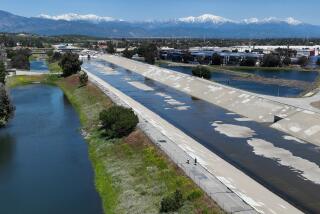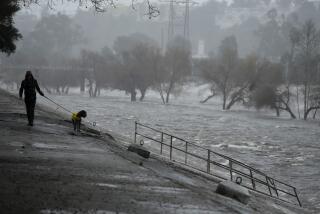Readers React: How much good will urban water cuts do?
To the editor: I agree with Nathanael Johnson that it’s time to stop approaching the conversation about water use as one about “farms versus cities,” but for reasons different than his. Finger-pointing simply misses the point. (“In the water crisis, it’s time to move beyond the farms vs. cities mindset,” op-ed, May 15)
However you slice it, city residents use only one-fifth of the state’s available water, as Johnson acknowledges. Nonurban use (agricultural and environmental) still accounts for the remaining 80%. So, assuming Johnson is correct that city residents “can cut water consumption with much less pain” than farmers, what good would those cuts accomplish?
Even if all urban water users tear out their lawns, cease flushing low-flow toilets and use water from the shower to water their few remaining plants, we would only be making a slight dent in the real problem — which is that California doesn’t have enough water to meet the needs of all of us.
The solution is to find more water or, more reasonably, ways to reuse the water we have, such as improved methods of water treatment.
Joanne O’Donnell, Los Angeles
..
To the editor: By including the flow of California’s natural rivers in the state’s water use equation, Johnson merely serves to highlight the hugely disproportionate use of water by agriculture. According to the chart that ran with the article, California’s farmers use more water than all our wild rivers and instream flow combined.
But more disturbing is his argument that, yes, drip irrigation is more efficient than flood irrigation, but since that wasted water flows back into the ground anyway (and evaporates into the blazing summer sky, which he doesn’t mention), then it’s not really wasted. By that logic, we can all water our lawns seven days a week and take half-hour showers, since all that water will eventually come back.
The fact is, mandating slow-drip irrigation is the fastest and simplest way to lower water use by our state’s biggest users. And the rest of us, as consumers of California’s bounty, should be willing to subsidize the cost of switching to that technology through fees on urban water use.
Anthony Lacques, Los Angeles
..
To the editor: While Johnson’s current numbers on water usage by agriculture and cities (40% versus 10%) differ starkly from the now-conventional 80/20 wisdom, the unsustainable ratio is still the same: 4 to 1.
Devoting 50% of the available water in a drought to maintenance of the environment does not upset me in the least. Where is it written that the delta smelt should be sacrificed to shore up agricultural profits made in foreign markets?
David L. Burdick, Ridgecrest, Calif.
..
To the editor: I am grateful to The Times for its coverage of the drought. Many of us are modifying our lives in response. Average home owners, myself included, have ripped out our lawns and installed drought-tolerant landscaping.
Yet so often, The Times has pictures of mansions featuring stunning swimming pools and expansive lawns. The takeaway seems to be that there is one set of rules for most of us, and another for the rich who can waste water with impunity.
Leah Corry, Santa Monica
..
To the editor: Although 40% of California’s water goes to agriculture, acreage for pastureland (for cattle, milk production, etc.) exceeds that for cropland. Johnson doesn’t address whether California really needs to produce so much meat.
Michael Haas, Los Angeles
Follow the Opinion section on Twitter @latimesopinion and Facebook
More to Read
A cure for the common opinion
Get thought-provoking perspectives with our weekly newsletter.
You may occasionally receive promotional content from the Los Angeles Times.






